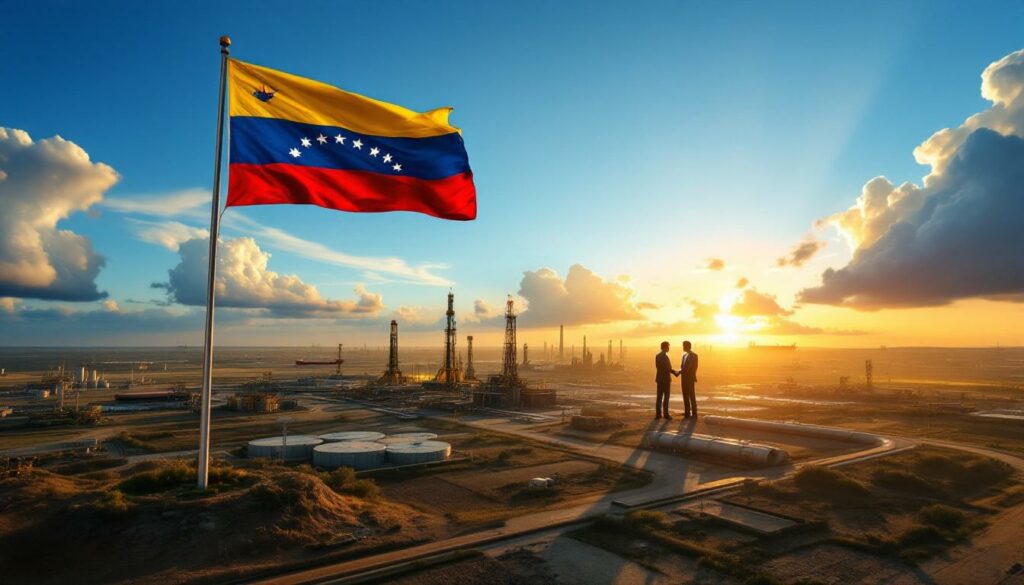Why Chevron's Potential Return to Venezuela Matters
The potential return of Chevron to Venezuela represents a pivotal shift in U.S. foreign policy and global energy dynamics. As Washington signals readiness to ease sanctions that have crippled Venezuela's oil industry for years, this development could reshape Western Hemisphere energy relationships and significantly impact global oil supply chains.
According to industry analysts, Chevron's reentry could add approximately 200,000 barrels per day (BPD) to global markets—a modest yet meaningful injection at a time of tight supply conditions and persistent geopolitical uncertainty.
"Venezuela sits on the world's largest proven oil reserves, yet produces less than a third of what it did a decade ago," notes energy economist Francisco Monaldi of Rice University's Baker Institute. "Chevron's technical expertise could begin reversing years of decline."
Despite the news of potential Venezuelan supply increases, global oil price movements have remained resilient. WTI crude traded at $66.38 per barrel and Brent at $69.51 as of July 2025, with traders focusing on broader market fundamentals rather than prospective supply additions.
How U.S. Sanctions on Venezuela Have Evolved
The Implementation and Impact of Sanctions
U.S. sanctions on Venezuela's oil sector have progressed through several increasingly restrictive phases since their initial implementation. What began as targeted measures against specific individuals and entities eventually expanded into comprehensive restrictions on the country's petroleum industry.
The most severe measures came in 2019 with a full oil embargo that effectively blocked Venezuela from its largest export market. These sanctions have had devastating consequences for Venezuela's production capacity, which plummeted from approximately 2 million BPD to under 700,000 BPD—a decline of more than 65%.
The sanctions regime included several critical components:
- Restrictions on PDVSA debt transactions and financing
- Prohibitions on diluent imports needed for heavy crude processing
- Limits on insurance coverage for tankers carrying Venezuelan crude
- Banking restrictions preventing normal payment mechanisms
Recent Policy Shifts and Diplomatic Developments
The Biden administration has gradually modified its approach toward Venezuela, exploring conditional sanctions relief as part of a broader recalibration of regional policy. This shift reflects several strategic considerations:
- Energy security concerns: Disruptions from the Russia-Ukraine conflict and Middle East tensions have highlighted the need for diversified supply sources
- Humanitarian implications: Recognition that sanctions have contributed to Venezuela's socioeconomic crisis
- Regional diplomatic dynamics: Changing political landscapes across Latin America
- Strategic competition: China and Russia have expanded their influence in Venezuela during the U.S. absence
"The U.S. is adopting a more pragmatic approach that acknowledges sanctions alone haven't achieved their intended political outcomes," explains Lisa Viscidi, energy specialist at the Inter-American Dialogue. "Energy diplomacy has become a more nuanced tool in Washington's policy arsenal."
What Chevron's Return Would Mean for Venezuela's Oil Industry
Potential Production Increases
Energy analysts estimate Chevron's renewed operations could add approximately 200,000 BPD to Venezuela's production within 6-12 months of receiving authorization. While significant for Venezuela, this volume represents just a fraction of the country's historical capacity.
The production timeline would likely follow three phases:
- Immediate rehabilitation (0-6 months): Reactivation of existing wells and basic infrastructure repairs yielding 50,000-75,000 BPD
- Medium-term recovery (6-18 months): Field optimization and secondary recovery implementation adding another 100,000-125,000 BPD
- Long-term development (18+ months): New drilling programs and major infrastructure rehabilitation potentially adding 200,000+ BPD
"Venezuela's heavy oil fields haven't been properly maintained for years," notes petroleum engineer Carlos Rossi. "Reservoir damage from improper practices will limit how quickly production can be restored."
Technical Expertise and Infrastructure Rehabilitation
Venezuela's oil infrastructure has deteriorated dramatically during years of underinvestment and limited maintenance. Chevron's return would address critical technical gaps:
- Expertise in heavy oil production: Venezuela's Orinoco Belt contains extra-heavy crude (8-15° API gravity) requiring specialized recovery techniques
- Access to capital: Infrastructure rehabilitation requires billions in investment that PDVSA cannot currently secure
- Modern operational practices: Implementation of digital oilfield technologies and enhanced recovery methods
- Supply chain restoration: Re-establishing connections to equipment suppliers and service companies
A key technical challenge involves upgrading facilities needed to process Venezuela's heavy crude into export-quality oil. Many of these facilities operate at less than 30% capacity due to deterioration and parts shortages.
Joint Venture Operations and Revenue Sharing
Any Chevron operations would operate through modified joint venture agreements with PDVSA. These arrangements would determine several critical aspects:
- Revenue sharing mechanisms: Likely a production-sharing contract model allowing Chevron to recover investments
- Operational control: Determining decision-making authority over field development plans
- Investment requirements: Minimum work programs and capital commitments
- Compliance frameworks: Ensuring operations meet international standards while navigating remaining sanctions
"The devil will be in the details of these agreements," says Russ Dallen of Caracas Capital Markets. "Venezuela desperately needs the revenue, but must also protect its sovereign resource rights."
How Would Global Oil Markets Respond?
Short-Term Price Implications
Despite news of Chevron's potential return, oil price rally has continued, supported by several bullish factors:
- Progress in U.S.-EU trade negotiations
- Expected Russian gasoline export restrictions
- Stronger-than-expected inventory draws (3.2 million barrels in the U.S., exceeding the 1.6 million forecast)
- Tight distillate stocks globally
As Tony Sycamore of IG Markets noted, "The crude market has found comfort in the bounce off $65 support," indicating traders are more focused on immediate supply-demand fundamentals than on potential future Venezuelan barrels.
Long-Term Market Balancing Effects
The additional Venezuelan supply would enter a market experiencing complex dynamics:
- Refinery economics: ICE gasoil crack spreads have eased below $25 per barrel but remain historically elevated, incentivizing refiners to maintain high utilization rates
- Inventory conditions: Distillate stocks remain at seasonal lows across major markets:
- U.S. inventories at lowest levels since 1996
- Singapore stocks down 1.19 million barrels week-on-week
- European ARA hub inventories at 1.75 million tonnes, lowest since January 2024
- OPEC production impact: The producer group continues to manage output carefully, potentially offsetting Venezuelan increases
- Demand uncertainty: Economic growth concerns in China and other major economies create questions about consumption trends
Impact on Regional Refining Operations
Venezuela's heavy crude is particularly well-suited for complex refineries designed to process such grades. The return of this supply could significantly benefit:
- U.S. Gulf Coast refineries: Many were specifically configured for Venezuelan crude before sanctions
- Asian refineries: Seeking alternatives to Middle Eastern grades as competition for these barrels intensifies
- European operators: Looking to replace sanctioned Russian barrels with similar quality alternatives
The quality differential is particularly important, as Venezuelan Merey blend (16° API, 2.5% sulfur) has different processing requirements than lighter alternatives.
What Challenges Remain for Venezuela's Oil Sector?
Infrastructure and Operational Hurdles
Even with sanctions relief, Venezuela faces enormous challenges in rehabilitating its oil sector:
- Deteriorated production infrastructure: Field analysis shows approximately 50% of active rigs have been idled since 2020
- Decline rates: Mature fields are experiencing decline rates of up to 70% without proper reservoir management
- Skills shortage: Many experienced petroleum engineers and technicians have left the country
- Logistical constraints: Export terminals, storage facilities, and pipeline systems require significant repairs
These infrastructure problems explain why production recovery will likely be gradual rather than immediate. According to oil service company Baker Hughes, Venezuela's active rig count in 2023 represented less than a quarter of pre-sanction levels.
Political and Economic Stability Questions
The success of any oil sector revival depends heavily on broader conditions within Venezuela:
- Political governance: Continued uncertainty over democratic processes and rule of law
- Economic policy: Hyperinflation has stabilized somewhat but remains problematic
- Basic services: Electricity outages continue to hamper industrial operations
- Investment climate: Concerns about contract enforcement and property rights
"Oil production requires long-term confidence in operating conditions," explains political risk analyst David Smilde. "Companies need assurance that the rules won't change arbitrarily mid-project."
Compliance and Transparency Requirements
International partners like Chevron would require substantial improvements in operational transparency:
- Financial compliance: Adherence to international anti-money laundering standards
- Anti-corruption measures: Implementation of robust internal controls
- Environmental standards: Addressing legacy issues including gas flaring and oil spills
- Social governance: Engagement with local communities and stakeholders
The compliance burden remains significant, as U.S. companies must navigate both specific license terms and broader regulatory requirements.
What Are the Broader Geopolitical Implications?
U.S.-Venezuela Relations
Modified sanctions signal potential for gradual normalization of relations, though significant political differences remain. This shift could create:
- Diplomatic engagement pathways: Reopening channels closed for years
- Humanitarian cooperation: Addressing Venezuela's ongoing crisis
- Democratic process discussions: Establishing frameworks for political reforms
- Economic reintegration: Reducing Venezuela's isolation from Western financial systems
"Energy diplomacy often precedes broader diplomatic normalization," notes former State Department official Patrick Duddy. "Oil has historically been a bridge even between adversaries."
Regional Energy Security
Increased Venezuelan production could enhance energy security across the Americas by:
- Diversifying supply sources: Reducing dependence on Middle Eastern imports
- Creating economic interdependence: Strengthening hemispheric energy relationships
- Supporting regional development: Generating economic activity in neighboring countries
- Stabilizing markets: Adding a strategic buffer against supply disruptions
With approximately 40% of Latin America's proven oil reserves, Venezuela's reintegration would significantly alter regional energy dynamics.
Global Energy Transition Considerations
Any revival of Venezuela's oil industry occurs against the backdrop of global energy transition efforts:
- Investment horizons: Companies must consider how long-term decarbonization trends affect project economics
- Environmental remediation: Addressing legacy environmental damage requires significant investment
- Balanced development: Opportunity to incorporate renewable energy alongside oil sector rehabilitation
- Climate commitments: Balancing immediate economic needs with Venezuela's Paris Agreement obligations
"The era of unbridled oil development is over," says climate policy expert Juan Carlos Sánchez. "Venezuela must consider how to rehabilitate its industry while preparing for the energy transition."
How Might This Affect Other Global Oil Producers?
OPEC+ Strategy Adjustments
OPEC+ may need to reconsider production quotas and strategy if Venezuelan production increases significantly:
- Quota considerations: Venezuela is exempt from OPEC quotas due to its collapsed production, but this could change
- Market share dynamics: Other heavy crude producers might face competition
- Price stability mechanisms: The group might adjust overall output to maintain price targets
- Coordination challenges: Incorporating a recovering Venezuela into the quota system
The producer group has historically shown flexibility in accommodating changing member circumstances, but Venezuela's potential recovery presents unique challenges.
Impact on Other Heavy Oil Producers
Increased Venezuelan heavy crude supply could particularly affect:
- Canadian oil sands producers: Already facing transportation constraints and pricing pressure
- Mexican Maya exporters: Competing directly in U.S. Gulf Coast markets
- Colombian heavy crude operations: Vulnerable to changing trade flows
- Middle Eastern heavy grade exporters: Potentially losing Asian market share
The quality comparison is particularly relevant:
- Venezuelan Merey: 16° API, 2.5% sulfur
- Canadian Syncrude: 32° API, 0.1% sulfur
- Mexican Maya: 22° API, 3.3% sulfur
These differences affect refining economics and transportation costs to key markets.
Investment Patterns in Global Oil Projects
Capital allocation decisions across the industry may shift based on:
- Comparative project economics: How Venezuelan opportunities stack up against alternatives
- Political risk assessments: Perceived stability of operating environment
- Return expectations: Required payback periods in various jurisdictions
- Long-term demand considerations: Market outlook for heavy crude grades
"Capital is finite in today's oil industry," explains energy finance specialist Antero Alvarado. "Every dollar invested in Venezuela is potentially diverted from other producing regions."
FAQs About Chevron's Potential Return to Venezuela
What specific sanctions would be eased to allow Chevron's return?
The U.S. Treasury Department would likely issue specific licenses through its Office of Foreign Assets Control (OFAC) permitting:
- Production, lifting, and sale of Venezuelan petroleum products
- Essential maintenance and safety operations
- Payment of certain operational expenses and taxes
- Limited reinvestment of proceeds
These licenses would include strict compliance requirements and reporting obligations.
How quickly could production increase after sanctions relief?
Industry experts suggest a phased approach:
- Initial production gains of 100,000-200,000 BPD possible within 6-12 months
- Focused on reactivating shut-in wells and basic infrastructure repairs
- Larger production increases requiring more substantial investments over 2-5 years
- Full recovery to pre-sanction levels potentially taking 5+ years
"Field deterioration is the primary limiting factor," explains petroleum engineer Nelson Hernandez. "Some reservoirs may never recover their previous productivity."
Would other international oil companies follow Chevron?
Other companies would likely adopt a wait-and-see approach, evaluating Chevron's experience before making significant commitments. Several factors would influence their decisions:
- Regulatory risk: Concern about future policy changes
- Investment terms: Attractiveness of fiscal arrangements
- Infrastructure access: Availability of export routes and processing facilities
- Political stability: Governance and rule of law considerations
European companies like Eni and Repsol, which maintained limited presence through special licenses, might move more quickly than other international operators.
How might this affect U.S. domestic oil producers?
Increased heavy crude imports from Venezuela could impact U.S. producers differently based on the oil grade they produce:
- Heavy oil producers: Might face more direct competition, particularly in Gulf Coast markets
- Light crude producers: Could benefit as refineries optimize their crude slates
- Transportation differentials: Changing pipeline economics as import patterns shift
- Refinery utilization: Potentially higher runs as input costs optimize
"The U.S. refining system was built with Venezuelan heavy crude in mind," notes refining analyst John Auers. "Restoring these historic trade patterns could improve overall system efficiency."
A Pivotal Moment for Global Energy Markets
Chevron's potential return to Venezuela represents more than just a corporate decision—it signals a possible realignment of hemispheric energy relationships and global oil flows. While significant challenges remain, this development could mark the beginning of Venezuela's reintegration into global energy markets after years of isolation.
The coming months will reveal whether this opportunity translates into meaningful production increases and economic benefits for Venezuela, or whether structural challenges will continue to limit the country's petroleum sector recovery despite sanctions relief.
What's certain is that global market impact is being closely monitored. As one trader noted, "Venezuelan barrels won't change the immediate supply picture, but they could significantly alter longer-term investment and trade patterns across the Americas."
For a country sitting atop the world's largest proven oil reserves yet producing less than a third of its capacity, Chevron's return represents both opportunity and challenge—a chance to rebuild, but under dramatically different global energy conditions than when US–China trade war sanctions were first imposed.
Want to Stay Ahead of the Next Major Resource Discovery?
Discovery Alert's proprietary Discovery IQ model delivers real-time notifications on significant ASX mineral discoveries, instantly empowering subscribers to identify actionable opportunities before the broader market. Visit our discoveries page to understand why historic discoveries have generated substantial returns for early investors.




